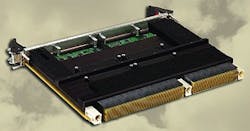Embedded computers with fast D/A converters for SIGINT and EW offered by Curtiss-Wright
ASHBURN, Va., 3 April 2013. Curtiss-Wright Controls Defense Solutions in Ashburn, Va., is introducing versions of the company's CHAMP-WB rugged 6U OpenVPX embedded computers with the TDAC-25 10-bit 25-gigabit-per-second digital-to-analog converter from Tektronix Component Solutions in Beaverton, Ore.
Curtiss-Wright first will deliver the TDAC-25 on the CHAMP-WB-DRFM card featuring the Tektronix 12.5-gigasample A/D converter and D/A converter-based TADF-4300 module. Curtiss-Wright and Tektronix designed the TADF-4300 together for use with the CHAMP-WB Xilinx Virtex-7 field-programmable gate array (FPGA)-based 6U VPX card.
The TDAC-25 D/A converter is an application-specific integrated circuit (ASIC) designed with defense, aerospace, telecom, commercial, and medical applications in mind. The device delivers as much as -60 dBc of dynamic range and enables direct-generation of wideband signals.
The TDAC-25, which Tektronix says is the world's fastest commercially available D/A converter, can increase the wideband RF data conversion performance for signal generation in demanding electronic warfare (EW), secure communications, signals intelligence (SIGINT), coherent optical systems, radar simulation, and commercial aerospace applications.
Introduction of the Tektronix TDAC-25 enables Curtiss-Wright to announce a D/A converter-only configuration of the CHAMP-WB featuring 25-gigabit-per-second capability in a ruggedized version.
Curtiss-Wright plans to provide the TDAC-25-based D/A converter-only configuration on the forthcoming CHAMP-WB-AWG (arbitrary waveform generator) card for direct generation of wideband RF signals, reducing the need for additional frequency conversion blocks.
For more information contact Curtiss-Wright Controls Defense Solutions online at www.cwcdefense.com.

